

| home | order | prices | models | features | options | gallery | reviews | for sale |
Started Jan 2008
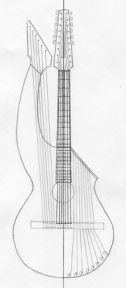 I thought I would describe the construction of a
sympathetic string harp guitar. It will have 6 melody strings,
6 sub basses, 8 super trebles and 12 sympathetic strings running
through the neck. I owe a great debt to Fred Carlson who has done amazing pioneering
work with sympathetic strings in his Sympitars.
I thought I would describe the construction of a
sympathetic string harp guitar. It will have 6 melody strings,
6 sub basses, 8 super trebles and 12 sympathetic strings running
through the neck. I owe a great debt to Fred Carlson who has done amazing pioneering
work with sympathetic strings in his Sympitars.
Here is a preliminary sketch which shows the basic layout of the
strings. The super trebles will be tuned with 5th string banjo
tuners mounted on the lower bout in order to help offset some
of the weight and provide better access to the cut away. The customer
wanted a simple look to suit his aesthetic and to keep the overall
cost down.
The top will be sitka spruce, sustainably harvested in Alaska, and the back and sides will be local black walnut which is abundant where I live. The neck will be mahogany with ebony fingerboard and bridge.
I will be using a fairly radical construction technique which I have never seen used in a harp guitar but it makes sense to me so I'll give it a try.
This design starts out with a sheet
of 1/2" baltic birch multi layer plywood, a high grade plywood
used in cabinet making. I consider this to be harp guitar grade
plywood!
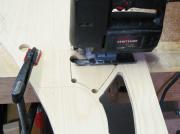 The inside shape is cut out with a jig saw. The
out side shape is cut out on a band saw and sanded smooth.
The inside shape is cut out with a jig saw. The
out side shape is cut out on a band saw and sanded smooth.
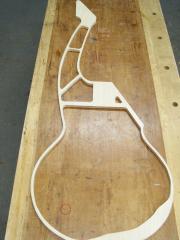 The plywood form all cut out and ready for the sides.
This will become the top rim.
The plywood form all cut out and ready for the sides.
This will become the top rim.
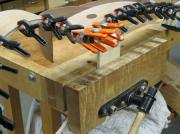 After
bending the sides over a hot pipe the sides are glued and clamped
to the plywood. With this method there is no assembly form required.
The plywood rim becomes part of the guitar.
After
bending the sides over a hot pipe the sides are glued and clamped
to the plywood. With this method there is no assembly form required.
The plywood rim becomes part of the guitar.
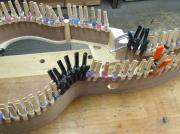 Kerfed
linings are glued on to the back side in the usual manner with
clothespins for clamps.
Kerfed
linings are glued on to the back side in the usual manner with
clothespins for clamps.
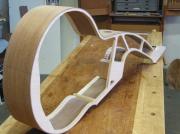 The
completed rim assembly. This structure is solid but light weight
and will be a rigid foundation for the neck and all the tuners.
The
completed rim assembly. This structure is solid but light weight
and will be a rigid foundation for the neck and all the tuners.
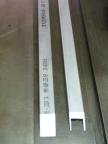
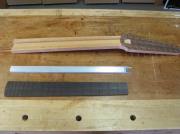 The
neck is reinforced by an aluminum channel which will allow room
for the 12 sympathetic strings. The channel was cut on my table
saw from 2024 aircraft aluminum and will epoxied into the mahogany
neck.
The
neck is reinforced by an aluminum channel which will allow room
for the 12 sympathetic strings. The channel was cut on my table
saw from 2024 aircraft aluminum and will epoxied into the mahogany
neck.
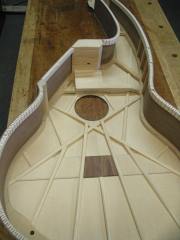 A view from the inside showing the
bracing on the top. I have used a combination X and fan bracing.
A view from the inside showing the
bracing on the top. I have used a combination X and fan bracing.
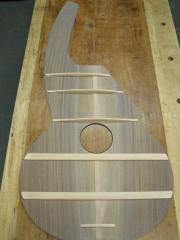 Walnut back with spruce bracing.
The hole is for access to the sympathetic strings and will be
covered with a removable plate.
Walnut back with spruce bracing.
The hole is for access to the sympathetic strings and will be
covered with a removable plate.
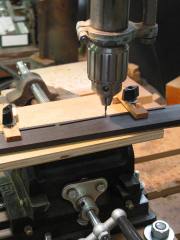 Making
the bridge using a drill press and a cross slide vise.
Making
the bridge using a drill press and a cross slide vise.
 The
completed bridge with all of the holes and slots.
The
completed bridge with all of the holes and slots.
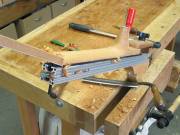 Carving
the neck with a some basic hand tools.
Carving
the neck with a some basic hand tools.
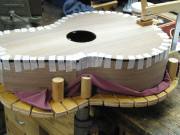 The
binding is glued on and held in place with masking tape.
The
binding is glued on and held in place with masking tape.
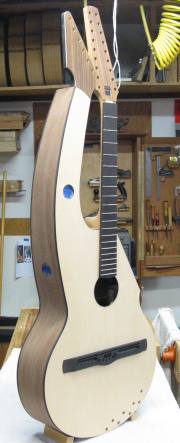 The
harp guitar "in the white" before the finish is applied.
The bridge is only temporarily attached and will be glued on after
the top is buffed out.
The
harp guitar "in the white" before the finish is applied.
The bridge is only temporarily attached and will be glued on after
the top is buffed out.
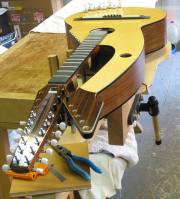 After
lacquering and buffing it's time to put all those tuners and strings
on. This takes a while.
After
lacquering and buffing it's time to put all those tuners and strings
on. This takes a while.
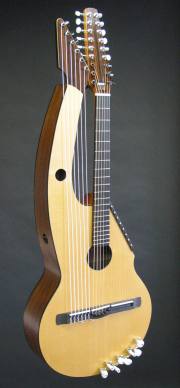 The final result all tuned up and ready for some
music. Click on the photo to see more detail pics.
The final result all tuned up and ready for some
music. Click on the photo to see more detail pics.
| home | order | prices | models | features | options | gallery | reviews | for sale |